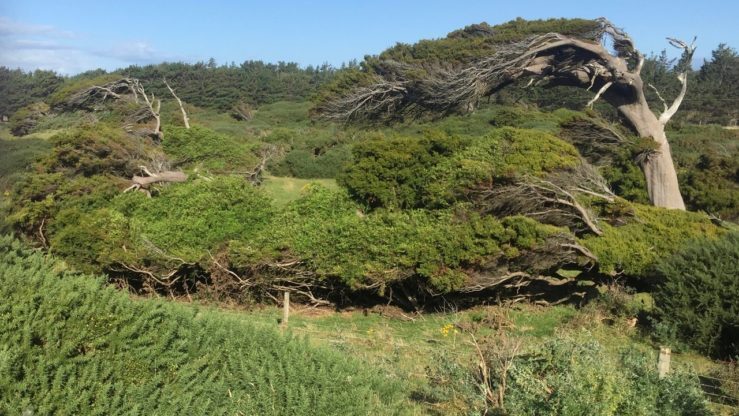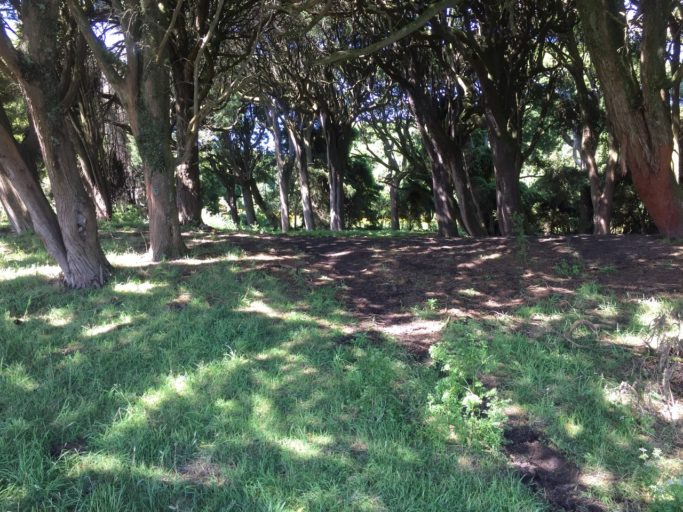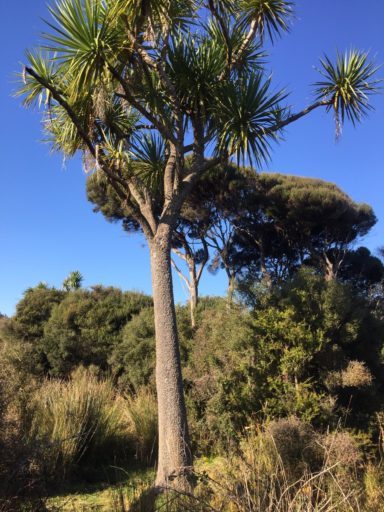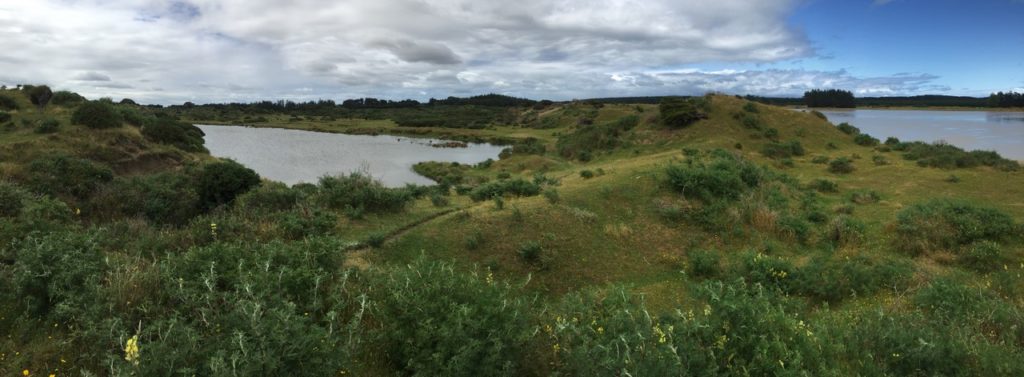In the far south of the South Island, in Otatara, Southland, there is a totara dune forest where ancient trees bend and twist and brace themselves against the prevailing winds. Sculpted by the winds, they grow in unusual shapes on the higher parts of the dry sand dunes.

“Totara dune forests are unusual and pretty special,” says Maurice Rodway, honorary ranger of the 81-hectare reserve where the totara grow. “There are only a few others like it in New Zealand.”
The reserve has only just been named – The Oreti Dunes Totara Forest – and it’s yet to be officially opened to the public, but this is planned for November 21 later this year. Before that happens, there’s a lot of work still to be done.
“The land was previously owned by Peter Knight who bought it around 1990/2000,” Maurice explains. “He was a laid-back farmer and didn’t farm it intensely. He had 150 cattle and 60-70 sheep. About half the block is open pasture and half native forest that the stock could roam through.”

Grazing by stock prevented regeneration of the understory, but the mature totara remained intact.
“There’s other forest too,” says Maurice, “big matai trees that are 1 metre in diameter at the base. They’re impressive – maybe 300 to 500 years old. There are big old manuka stands and also kahikatea growing where the land is wetter towards the east. But the special feature is the totara growing on the dunes.”
The farm block has been recognised as special for some time.
“It was on the radar of the Department of Conservation and conservationists,” says Maurice, “And an ecological assessment was done while it was under the ownership of Peter Knight. Peter died about a year ago and the family trust put it on the market. A few people in Otatara knew about the property and its ecological value.”
Those locals, including Maurice and Department of Conservation botanist Brian Rance, got together to try and find a way to purchase the block.
“Brian had met representatives of the Native Forest Restoration Trust at a conference recently,” says Maurice. Brian contacted NFRT board member Geoff Davidson and chairman, Tim Oliver. “They came down to have a look and impressed by the bush – and also impressed by the support it had from the community. We convinced them to put in a bid for the block and it was successful.”
Settlement date was 20 May, earlier this year and the local supporters, now officially an Advisory Group for the Native Forest Restoration Trust reserve, have been busy ever since. Maurice is Honorary Ranger and Dallas Bradley, who runs the Otatara Pestbusters neighbourhood trapping programme, has started organising the pest control side.
“We started straight away establishing two rodent monitoring lines,” says Dallas. “We didn’t know how many pests there would be, but previously people shooting rabbits and possums had reported seeing a few rats in the trees.”
Dallas says the nature of the block is totally different from what he has ever experienced.
“There’s a lot of pure totara and muehlenbeckia on the dunes and the understorey is non-existent. There’s also a lot of grassy swales among the dunes which make a nice corridor for rabbits and possums. We put out some chew cards and proved very quickly that they were possums and rats.”
Dallas designed a layout of pest control lines, approximately 70 metres apart, along the dune crests, with bait stations every 50 metres for rats.
“The first thing we caught was a ferret,” Dallas reports. “We caught two more ferrets within a week and there have been none seen since.”
There’s been no sign of stoats or weasels so far, which is a bit of a surprise.
“The property borders the Oreti River lower tidal reaches where the river is about 250 metres wide. On the other side of the river is the Sandy Point Domain, which is a stronghold for stoats and ferrets, so we’re waiting to see how much mustelid reinfection we get.”
Behind the scenes, work is also underway to get ready for the November opening day.
“Signs have been put up for a carpark,” says Maurice, “And before the opening in November, more signs will go up and tracks will need to be marked. Cathy Macfie and Helen Stewart, local graphic designers who live nearby, are doing the public signage and interpretation panels. Jesse Bythell is our local QE II Trust representative, and an Advisory Group member. The land will be put under QE II covenant.”
The Advisory Group has also written a management plan which is ‘almost finalised’ Maurice reports.

“Our longterm goal is to restore the land to forest over 50 years,” he explains. “It’s too big to restore by planting out, but there are many mature trees and lots of seeds in the understorey that can grow now the cattle are gone. Coprosma and totara seedlings are growing already.”
“Other plants including wineberry, koromiko/hebe, broadleaf and palatable coprosmas were eaten out by stock. Invercargill City Council has donated 1,000 of those plants and we’re planting them out at the moment so that they can then seed and regenerate.”
There’s been more good news on the funding front just in the last week.
“This week we received $5,000 from Environment Southland for pest control,” Maurice says. “It’ll be used for traps, baits and bait stations.”
“We’ve been using borrowed equipment up till now,” says Dallas who is also the Volunteer Coordinator for Otatara Pesterbusters – a useful overlap when it came to borrowing gear.
“We built our own bait stations and borrowed DOC 200 traps, a DOC 250 and some Possum Masters from the Otatara Pestbusters,” he explains. “We put two contrac rat baits in each bait station. After two months and with Environment Southland assistance, using standard methodology, we did our first round of monitoring and got 0% rats and 15% mice. That doesn’t mean there’s no rats though,” he cautions. “We caught a rat the next day!”
Two trail cameras have also been deployed.
“The trail cameras showed that possums were showing up regularly and not going into the Possum Masters,” says Dallas. “So we have used leghold traps to cleanup the possums and we think we’re getting on top of them.”
“The monitoring shows we’ve had a good knockdown of rats and mice and we’ll continue baiting, but we want to use more traps in the long term. We didn’t have many rat traps at the beginning,” he explains.
Dallas is excited about the $5,000 grant from Environment Southland’s ‘Environmental Enhancement Fund’.
“It will fund the initial setup costs of the animal pest control,” he explains, “mostly traps and some bait stations. It’s fantastic! Very much appreciated. It gives us a very good base to work from. We’ve very pleased with progress so far and have also been super-fortunate to have a part-time, 20 hours per week contractor to help out, including monitoring the pest control lines.”
Another recent windfall has been the donation of 20 Goodnature A24 traps.
“We’ve just put those out. They’re a really valuable addition to the programme as they’re good to go 24/7,” Dallas says.
While there have been no formal surveys of native wildlife yet, the Advisory Group is planning to do bird counts.
“There are wetlands on the property, including a 1 hectare pond and an ephemeral wetland which we expect to drain in summer as its very sandy,” says Maurice.
Part of the land also borders the Oreti River.
“There are paradise shelducks and mallards, black swans, pukeko, a good population of scaup,” says Maurice. “A white-fronted shag was seen in the pond beside the Oreti River and there are also little shags. In the bush, there’s the full range: tūī, woodpigeons (kereru), bellbird (korimako), grey warblers (riroriro), a good population of fantails (pīwakawaka) and harriers (kāhu). Dallas has heard some red crowned parakeets a couple of times, but they’re not regularly heard or seen. They may be in future though, as the bush gets denser. There are a few South Island tomtits (ngirungiru) too.”

“Southern Institute of Technology are keen to be involved in the reserve,” says Maurice. “SIT students are monitoring the pond area and will also do some pest monitoring with chew cards and tracking tunnels.”
“The monitoring informs targeted pest control,” adds Dallas, “especially for possums. On a couple of occasions, we’ve also had people with possum-hunting dogs. They’ve indicated a few possums and caught one. It helps us know where the possums are hanging out.”
The first steps are being taken to monitor regenerating plant growth too, with the help of Advisory Group member and professional botanist, Brian Rance.
“Last weekend, Brian organised DOC botanist volunteers to set up monitoring plots to measure growth and plant diversity,” says Maurice. “They are monitoring plants in different habitats on the property.”
The researchers are also planning to compare regeneration in protected areas with more open areas of the block which will initially be lightly grazed.
“Part of the land is open pasture – about 40 hectares,” says Maurice. “We’ve got an agreement with a local farmer to graze sheep on the area, but the farming regime won’t be intensive. It will be a regenerative system. Totara seedlings are spiky and not very palatable. We hope the totara trees will seed and regenerate in the pasture area and that the sheep will keep the grass low, so it doesn’t smother the seedling trees. We’ll monitor totara tree regeneration under grazing to see whether restoration is possible on a working farm. There’s also a lot of gorse on the property which we will need to manage as a nurse crop for native plants.”
It’s early days yet, but if all goes to plan, this unique southern landscape will be a resource for community recreation, education and research as the native forest and wetlands regenerate and we learn more about totara dune forests and the plant and wildlife communities they support.
“It was great to get the land,” says Dallas, “Great that people made it happen. It’s such a fantastic long term asset. And with the small creeks on the property, there are a wetland opportunities too.”
Check out this drone image of Oreti Dunes Totara Forest by SIT student Christeena Eyyalil and technician Phil Lockett. This and similar images may be used in the future to monitor changes in the forest over time.

